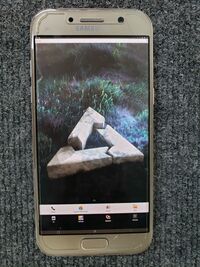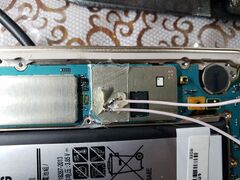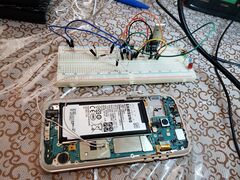Samsung Galaxy A5 2017 (samsung-a5y17lte)
| This device runs a Downstream kernel. Some UIs will not work, and most features (3D acceleration, audio, etc.) may be broken. |
 Samsung Galaxy A5 | |
| Manufacturer | Samsung |
|---|---|
| Name | Galaxy A5 (2017) |
| Codename | samsung-a5y17lte |
| Released | 2017 |
| Type | handset |
| Hardware | |
| Chipset | Samsung Exynos 7880 |
| CPU | 8x 1.9 GHz Cortex-A53 |
| GPU | Mali-T830 MP3 |
| Display | 1080x1920 Super AMOLED |
| Storage | 32 GB |
| Memory | 3 GB |
| Architecture | aarch64 |
| Software | |
Original software The software and version the device was shipped with. |
Android (TouchWiz) 6.0.1 |
Extended version The most recent supported version from the manufacturer. |
Android (TouchWiz) 8.0 |
| postmarketOS | |
| Category | downstream |
Mainline Instead of a Linux kernel fork, it is possible to run (Close to) Mainline. |
no |
pmOS kernel The kernel version that runs on the device's port. |
3.18.14 |
Unixbench score Unixbench Whetstone/Dhrystone score. See Unixbench. |
1691.5 |
| Device package |
|
| Kernel package |
|
Flashing Whether it is possible to flash the device with pmbootstrap flasher. |
Broken
|
|---|---|
USB Networking After connecting the device with USB to your PC, you can connect to it via telnet (initramfs) or SSH (booted system). |
Works
|
Screen Whether the display works; ideally with sleep mode and brightness control. |
Works
|
Touchscreen |
Works
|
| Multimedia | |
3D Acceleration |
Untested
|
Audio Audio playback, microphone, headset and buttons. |
Untested
|
Camera |
Untested
|
| Connectivity | |
WiFi |
Works
|
Bluetooth |
Untested
|
GPS |
Untested
|
| Modem | |
Calls |
Untested
|
SMS |
Untested
|
Mobile data |
Untested
|
| Miscellaneous | |
FDE Full disk encryption and unlocking with unl0kr. |
Untested
|
USB OTG USB On-The-Go or USB-C Role switching. |
Works
|
| Sensors | |
Accelerometer Handles automatic screen rotation in many interfaces. |
Untested
|
Contributors
- dsankouski
Maintainer(s)
Users owning this device
- Bastindo (Notes: very good condition, running Lineage 20)
- Danfigasystems (Notes: 16GB model)
- Dsankouski
- Keith. (Notes: Needs a new battery)
- KQuote03
- LegoLivesMatter (Notes: Dead screen, possibly the display cable just got disconnected?)
- Manty (Notes: Android development)
- SuperPou (Notes: Broken screen, touch works though)
- VertexIsHere (Notes: Dead battery)
How to enter flash mode
When the device is fully powered off, hold Power, Volume Down and Home for a few seconds.
A (turquoise) download mode warning screen should appear, press Volume Up to confirm.
Installation
It is recommended to sideload an android recovery zip through TWRP for the easiest process, since heimdall freaks out about the subpartitions in SYSTEM and won't move past ~7%.
You can use pmbootstrap flasher flash_kernel and then use netcat or similar to flash SYSTEM, but this is a longer and more redundant method.
$ pmbootstrap install --android-recovery-zip
$ pmbootstrap flasher --method=adb sideload
Notes
USB
Device is equipped with usb type-c receptacle. No UART JIG mode cable schematic available as of 04.01.2020. However, it is possible to use chainloaded u-boot to get uart on usb. See u-boot port readme for instructions
Available MUIC info:
- The receptacle is managed by s2mu004 kernel module. Module is capable to manage non type-c receptacles (see CONFIG_MUIC_S2MU004_NON_USB_C_TYPE option)
- Receptacle has non standard pinout: B12 (considering, A row facing top, B row facing bottom side of the phone) pin is not connected to the ground.
- Device can detect water in usb receptacle, by measuring resistance between B12 pin and ground.
- Device can detect plug attach, with ALL pins unconnected, including GND and VBUS pins. How?
- Attaching 619K resistor to B12 pin results in ADC_JIG_UART_ON value in ADC register, during water detection sequence.
- Enter UART mode by attaching resistors should be possible in NON type-c mode. (file s2mu004-muic.c ,lines 2835,2797)
- Device has no USB type-c debug accessory mode(tried both with rd/rd and rp/rp resistors)
- UART mode detection most likely is implemented in muic firmware, if exists, or chip logic.
Open questions:
- How device can detect plug attach, when ALL plug pins are unconnected.
- How device detects UART debug cable attach?
Muic driver sysfs attributes are in /sys/devices/virtual/sec/switch folder
Wlan
wifi module gets initialized after 180 seconds. This is due to missing firmware files, and 60 secs timeout.
To connect, use wpa_supplicant:
Create wpa supplicant config
/etc/wpa_supplicant/wpa_supplicant.conf ctrl_interface=/run/wpa_supplicant update_config=1
Add wlan access point authentication
wpa_passphrase <access point> <password> >> /etc/wpa_supplicant/wpa_supplicant.conf
Launch wpa supplicant
sudo wpa_supplicant -B -i wlan0 -c /etc/wpa_supplicant/wpa_supplicant.conf sudo dhclient wlan0
UART cable
Attention: Author is not responsible for any damage to your devices. Signal level is 1.8V. You may fry your board, using standard 3.3V - 5V UART.
It is possible to connect to UART port(/dev/ttySAC2) on the mainboard. It is located on pins 1(RX), 2(TX) of the test port, and used by bootloader to log loading process.
Bill of materials
- Adhesive tape
- Precise soldering equipment
- USB - UART converter (you need also level shifter, if converter does not support 1.8V signals. I used schematic on two transistors)
- Breadboard
- Wires
- Thermal glue
- Assembly photos
-
Wires, soldered to UART port.
-
a5y17lte, connected to USB - UART converter via level shifter.
Enabling console output
Downstream kernel
- Build kernel with options:
- CONFIG_CMDLINE="earlycon=exynos,0x13820000,115200n8 console=ttySAC2,115200"
- CONFIG_CMDLINE_EXTEND=y
- Optional (enable login console on ttySAC2)[1]:
UART USB-debug cable schematic
Currently there's no automatic way to switch MUIC on debug uart. It may be done with u-boot custom port.
Phone--------------------------------------PC
USB type-c---------------------------------UART adapter
A6 (D+, Rx)--------------------------------Tx
A7 (D-, Tx)--------------------------------Rx
A1 and / or (B1) --------------------------GND
A4 and / or (A9, B4, B9)-------------------5V charging
Main board
-
Test port pin numbering
Pin 1 is RX, pin 2 is TX.
Mainlining
Exynos calibration table driver (ect_parser.c)
Exynos calibration table driver - simple driver, that reads and parses predefined cpu address range. It has voltage, cpu, gpu frequency tables, and more.
Legacy driver uses __raw_read macro to access data. Calibration table resides in volatile cpu address region (probably loaded there by bootloader into RAM?). One can write to ect cpu address region
U-boot
Has support in main tree. See also u-boot docs
Hardware
| Component | Model | Notes |
|---|---|---|
| Flash | Samsung BJTD4R | 32GB |
| Charging | Samsung s2mu004 | |
| Touchscreen | Zinitix BT532 | |
| Touchkeys | Abov FT1804 | |
| Gyroscope/Accelerometer | STMicroelectronics K6DS3TR | |
| Light/Proximity sensor | ams TMD3725 | |
| Magnetometer | AKM (Asahi Kasei Microdevices) AK09916C | |
| Barometer | STMicroelectronics LPS25H | |
| FM Radio | Silicon Labs si47xx | |
| Wi-Fi/Bluetooth | Qualcomm Atheros ar6k | Exact model unknown, could be one from this table |
| Fingerprint | EgisTec ET5XX | Connected via SPI |
| Rear camera | Samsung S5K3P8 | Phone reports "s5k3p8sx" as front camera |
| Lens actuator | (Samsung?) AK7372 |


